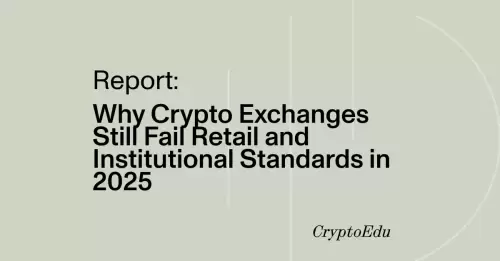 |
|
 |
|
 |
|
 |
|
 |
|
 |
|
 |
|
 |
|
 |
|
 |
|
 |
|
 |
|
 |
|
 |
|
 |
|
Articles d’actualité sur les crypto-monnaies
Imagine logging into your bank account, sending money, or applying for a loan without leaving your favorite financial app
May 06, 2025 at 10:54 pm

In today's interconnected world, logging into your bank account, sending money to a friend, or applying for a loan can be done without leaving your favorite financial app. But have you ever stopped to consider what allows these applications to seamlessly communicate with one another, sharing data and services in real-time? The answer lies in Application Programming Interfaces, commonly known as APIs.
APIs act as the invisible engines powering innovation in financial services. They are programmable building blocks that enable seamless integration of applications, facilitate efficient data sharing, and empower financial institutions to deliver personalized customer experiences.
As the financial sector continues its rapid digital transformation, understanding the role and impact of APIs has never been more crucial. This article delves into the key statistics of APIs in financial services for 2025, providing valuable insights into the growth, security, and regulatory compliance aspects of this technology.
Whether you’re a fintech enthusiast or a banking professional, these statistics will guide you through the evolving API landscape and its role in shaping the future of financial services.
Editor’s Choice: Key API Milestones in Financial Services
Year | Milestone
---|---
2000 | First generation of APIs for financial services are deployed, mainly focused on banking and payments.
2008 | The term "Open Banking" emerges, emphasizing the need for increased data portability and interoperability between financial institutions.
2015 | Open banking regulations are introduced in Europe with the Payment Services Directive 2 (PSD2).
2020 | The COVID-19 pandemic accelerates the adoption of APIs for remote banking services and contactless payments.
2025 | Over 80% of financial institutions have a dedicated API strategy in place.
Growth and Adoption of APIs in Financial Services
Stat | Value
---|---
Number of APIs deployed by large banks: 10,000+
Average number of APIs used by fintechs: 50+
Percentage of banks that have adopted an API-first strategy: 65%
Average time to market for new financial products using APIs: 6 months
Common types of APIs in financial services: banking, payments, lending, insurance, investment
Recognizing API Security as a Business Priority
Stat | Value
---|---
Percentage of financial institutions that have experienced at least one API security incident in the past year: 38%
Average cost of an API security breach: $3.92 million
Key API security concerns: authentication, authorization, data breaches, and malicious actors
Best practices for securing APIs: input validation, output encoding, and code review
Regulatory Compliance and APIs
Stat | Value
---|---
Number of regulatory reports simplified by using APIs: 15
Time savings in meeting compliance requirements with APIs: 25%
Common financial regulations impacting API integration: KYC/AML, GDPR, and CCPA
Key benefits of APIs for compliance: efficiency, accuracy, and transparency
Open Banking and API Landscape
Stat | Value
---|---
Number of open banking APIs available in the EU: 10,000+
Common types of data shared through open banking APIs: account balances, transactions, and payment details
Key trends in the open banking ecosystem: hyperpersonalization, embedded finance, and new revenue streams
Biggest challenges in open banking implementation: data privacy, security, and interoperability
Key Benefits for Stakeholders
Stakeholder | Benefit
---|---
Financial institutions | Increased efficiency, new revenue channels, improved customer experiences, and faster time to market for new products and services
Fintechs | Greater access to financial services data and technologies, enabling them to develop innovative solutions quickly
Consumers | More choice, convenience, and control over their financial products and services
Governments and regulators | Enhanced financial inclusion and stability
Strategic API Models in Banking Services
Model | Description
---|---
Platform as a Service (PaaS) | Banks provide a set of core banking APIs that fintechs can use to build customized financial products and services.
Banking as a Service (BaaS) | Fintechs can access a full suite of banking services, such as deposits, lending, and payments, through APIs.
Open API Portal | Banks create a central repository where they document and publish their APIs to internal and external developers.
Country-Specific Statistics and Information
Country | Stat
---|---
United States | 70% of large enterprises in the U.S. have adopted an API-first strategy.
United Kingdom | The Open Banking Standard in the U.K. mandates that financial institutions must make certain APIs available to third-party providers.
China | Ant Group's open platform provides APIs for over 1 million developers.
India | The government of India is promoting the use of APIs in financial services to drive financial inclusion.
Recent Developments
- In 2023, several major banks announced significant investments in expanding their API capabilities.
- The Fintech Association of Nigeria (FEAN) is encouraging banks and fintechs
Clause de non-responsabilité:info@kdj.com
Les informations fournies ne constituent pas des conseils commerciaux. kdj.com n’assume aucune responsabilité pour les investissements effectués sur la base des informations fournies dans cet article. Les crypto-monnaies sont très volatiles et il est fortement recommandé d’investir avec prudence après une recherche approfondie!
Si vous pensez que le contenu utilisé sur ce site Web porte atteinte à vos droits d’auteur, veuillez nous contacter immédiatement (info@kdj.com) et nous le supprimerons dans les plus brefs délais.
-

-

-

-

-

- Les perpétuaux décentralisés planent: le volume atteint un haut de tous les temps, laissant les CEX dans la poussière?
- Aug 05, 2025 at 03:38 pm
- Les futurs perpétuels décentralisés sont en plein essor! Juillet a vu un volume de trading record, dirigé par Hyperliquide. Cette poussée de Defi peut-elle remettre en question les échanges centralisés?
-

- Décodage MYCUSD: Prévision de la crypto pour le succès des actifs numériques
- Aug 05, 2025 at 03:37 pm
- Naviguez dans le paysage de la cryptographie MYCUSD avec des prévisions efficaces. Comprendre la dynamique du marché, les facteurs clés et les stratégies d'investissement éclairé dans les actifs numériques.
-

- Crypto, CEFI et Trust Gaps: Navigation de la frontière numérique en 2025
- Aug 05, 2025 at 03:34 pm
- En 2025, le paysage cryptographique fait face à des lacunes de confiance dans le CEFI, malgré des innovations comme l'intégration de la cryptographie de Paypal. L'équilibrage de l'innovation avec une protection des utilisateurs robuste reste la clé.
-

-

- CEINIOG COIN de James Howells: une histoire de retour de Bitcoin?
- Aug 05, 2025 at 03:26 pm
- James Howells, connu pour avoir perdu 8 000 Bitcoins, vise un retour crypto avec CEINIOG COIN, intégrant la blockchain de Bitcoin. Est-ce que cela réussira malgré les revers et les questions de financement passés?




























































